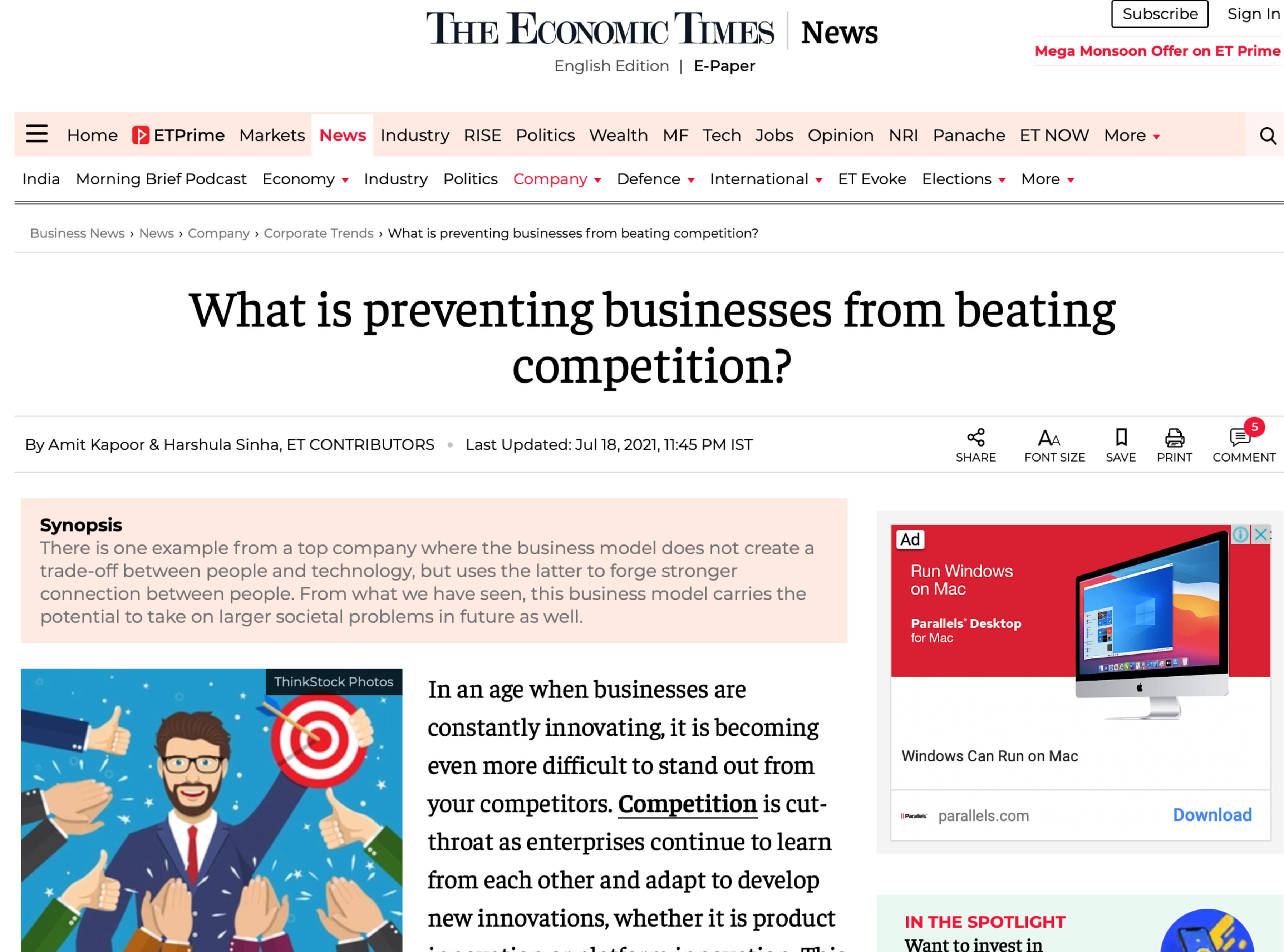What is preventing businesses from beating competition?
In an age when businesses are constantly innovating, it is becoming even more difficult to stand out from your competitors. Competition is cut-throat as enterprises continue to learn from each other and adapt to develop new innovations, whether it is product innovation or platform innovation. This could ultimately lead to homogenization of business models, a red ocean competition and an unfortunate return to the zero-sum game of price wars. This raises several questions: Is this the end of product innovation? Is customer-centric approach the answer? Or, are we fundamentally doing something wrong?
To answer this, we can go back to the beginning of it all. Modern economics is largely concerned with the question of wealth generation and wealth distribution but the subject also has its roots in ethics. Its ethics-related tradition can be traced back to the Greek philosopher, Aristotle, who related the subject to human ends. According to Aristotle, economic action is necessary for survival and a means to achieving a good life. Hence, though the subject is concerned with wealth, it is not the good that humans seek but a means to the end. Arguably, modern economics has lost touch with its ethical roots. As long as businesses are concerned with only profit-making, the cost of eschewing ethics are bound to be incurred in the long run.
Thus, the issue is possibly as simple as companies having lost sight of the end: the people. Profits are undeniably essential to survival of a business, but businesses too are part of the society. It is, after all, the people who build and run an organization and the society that provides its resources for its operations. The question is, how to reconcile the seemingly conflicting purpose of creating value for shareholders as well as for the people at large? It requires a paradigm shift in business management that puts people at the centre of its functioning. The steady growth of leading white goods manufacturer, Haier Group, is testament to the success of this approach.
Haier’s business model, called the Rendanheyi model, follows the principle of “human values comes first”. The term “Rendanheyi” is composed of three terms- “Ren” meaning employees or people, “Dan” or user needs, and “Heyi”, which means integrating employees and user needs. The model is considered people-centric because it puts the consumers, the employees, and the external partners as the axis on which business operates and evolves its strategies.
The core idea of the Rendanheyi model is to create “zero distance” with users in order to address their needs better. In stead of creating a product and then pushing it in the market, Haier aims to understand user needs first. In the age of Internet of Things (IoT) where interconnectedness between people, between things, and between people and things has resulted in an abundance of data, it can be leveraged to get a deeper insight into user needs.
The “Ren” or the employees play a pivotal role in the Rendanheyi model. Haier achieves its “zero distance” with users through its employees who directly face users. This is made possible by replacing the linear management model with Ecosystem Micro Communities (EMCs). An EMC is a community of Microenterprises (MEs), which are further composed of 7-8 employees who interact with users and cater to their needs. They have the right to make decisions, the right to hire talent, and the right to distribute compensation. Meanwhile, the functional departments merged into a single, shared services platform, provide finance, HR, legal, and IT services to the MEs. In this way, employees become entrepreneurs who create value for users and get paid by the users commensurate to the degree of value they are able to create for them. By connecting employee remuneration directly with the user value they create, the Rendanheyi model creates a fair incentive structures for driving efficiency and thereby, enhances employee wellbeing.
By keeping zero distance with users, MEs have also been able to gauge how user focus in the IoT age has shifted from isolated products to holistic experience-based lifestyle solutions. For example, products like Amazon Echo or Google Home speakers demonstrate how devices like speakers can be reinvented to offer a much broader user experience, and consumers are seeking out such products too. Since a single ME is too small to offer such comprehensive solutions, the EMCs bring together MEs from different industries to address user needs and co-create solutions.
EMCs are a new paradigm in a model that continuously evolves to align with user needs. As such, EMCs are open and dynamic, and therefore, allow external stakeholders to join them to co-create solutions and share value. By driving business offerings through their myriad of complex needs, the users also become co-creators and lead to further expansion of EMCs as varying needs result in development of more MEs. Thus, through this ecosystem of users, enterprises and other stakeholders, the Rendanheyi model elevates the user experience, maximizes value for employees as well as the external stakeholders that join the EMCs, which helps the ecosystem evolve without leaving anyone behind. In this way, the Rendanheyi model is a gamechanger that eliminates the element of zero-sum game. Instead of going for the bigger share of the pie, the stakeholders within the ecosystem, incentivised by the interconnected nature of value creation, rather aim to augment value for others.
By keeping people as the end in sight, the Rendanheyi model leverages the abundance of data and interconnectedness facilitated by the IoT to serve a much larger purpose than only creating shareholder value. Since the end sought is value creation for all individuals involved, Haier’s business model does not create a trade-off between people and technology, but uses the latter to forge stronger connection between people. In the future, the Rendanheyi model carries the potential to take on larger societal problems as well. Just as the EMCs enable cross-sectoral collaboration to address user needs, solving larger social problems pertaining to health, education and so on, also require similar collaborative efforts. This can begin a new chapter in the business ecosystem that has long functioned as an entity external to the society.
The article was published with Economic Times on July 18, 2021.
























